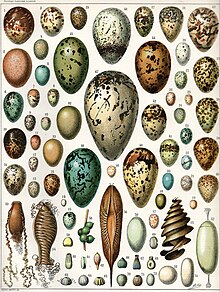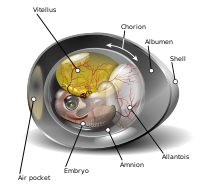
Back Eier (biologie) AF Ei ALS Uevo AN Æg ANG بيضة (أحياء) Arabic بيضه ARZ Güevu (bioloxía) AST Wow ATJ K'awna AY Yumurta (anatomiya) AZ
This article needs additional citations for verification. (February 2019) |



An egg is an organic vessel grown by an animal to carry a possibly fertilized egg cell (a zygote) and to incubate from it an embryo within the egg until the embryo has become an animal fetus that can survive on its own, at which point the animal hatches.
Most arthropods, vertebrates (excluding live-bearing mammals), and mollusks lay eggs, although some, such as scorpions, do not.
Reptile eggs, bird eggs, and monotreme eggs are laid out of water and are surrounded by a protective shell, either flexible or inflexible. Eggs laid on land or in nests are usually kept within a warm and favorable temperature range while the embryo grows. When the embryo is adequately developed it hatches, i.e., breaks out of the egg's shell. Some embryos have a temporary egg tooth they use to crack, pip, or break the eggshell or covering.
The largest recorded egg is from a whale shark and was 30 cm × 14 cm × 9 cm (11.8 in × 5.5 in × 3.5 in) in size.[1] Whale shark eggs typically hatch within the mother. At 1.5 kg (3.3 lb) and up to 17.8 cm × 14 cm (7.0 in × 5.5 in), the ostrich egg is the largest egg of any living bird,[2]: 130 though the extinct elephant bird and some non-avian dinosaurs laid larger eggs. The bee hummingbird produces the smallest known bird egg, which measures between 6.35–11.4 millimetres (0.250–0.449 in) long and weighs half of a gram (around 0.02 oz).[2]: 132 Some eggs laid by reptiles and most fish, amphibians, insects, and other invertebrates can be even smaller.
Reproductive structures similar to the egg in other kingdoms are termed "spores", or in spermatophytes "seeds", or in gametophytes "egg cells".
- ^ "Whale Shark – Cartilaginous Fish". SeaWorld Parks & Entertainment. Archived from the original on 9 June 2014. Retrieved 27 June 2014.
- ^ a b Khanna, D.R. (2005). Biology of Birds. New Delhi, India: Discovery Publishing House. ISBN 978-81-7141-933-3. Archived from the original on 10 May 2016.